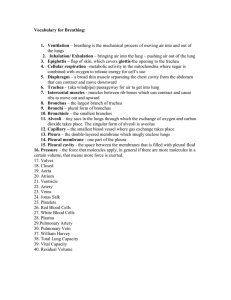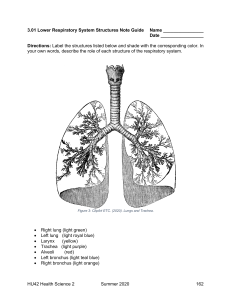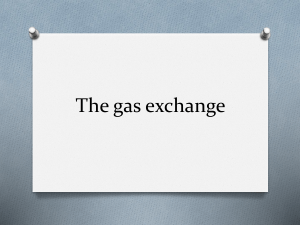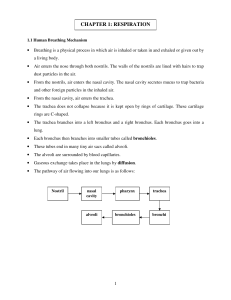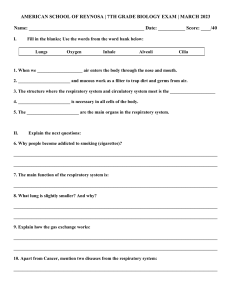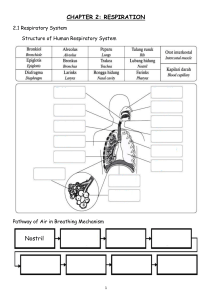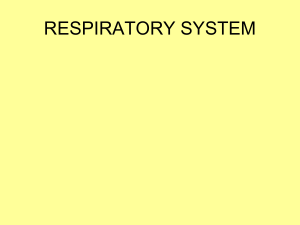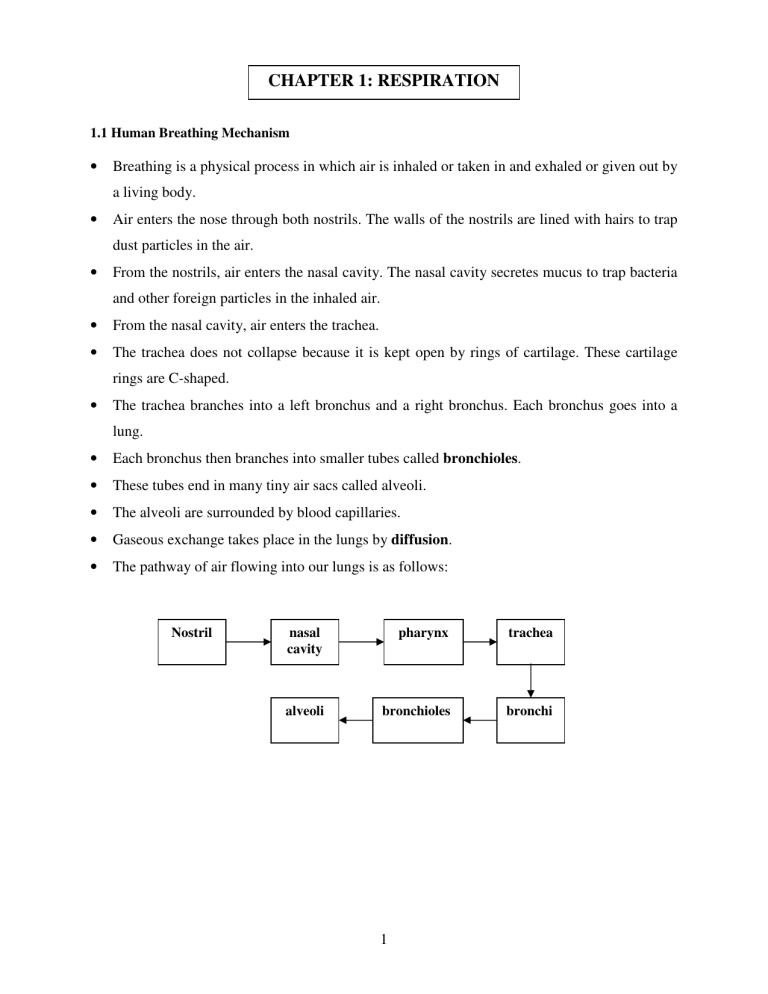
CHAPTER 1: RESPIRATION 1.1 Human Breathing Mechanism • Breathing is a physical process in which air is inhaled or taken in and exhaled or given out by a living body. • Air enters the nose through both nostrils. The walls of the nostrils are lined with hairs to trap dust particles in the air. • From the nostrils, air enters the nasal cavity. The nasal cavity secretes mucus to trap bacteria and other foreign particles in the inhaled air. • From the nasal cavity, air enters the trachea. • The trachea does not collapse because it is kept open by rings of cartilage. These cartilage rings are C-shaped. • The trachea branches into a left bronchus and a right bronchus. Each bronchus goes into a lung. • Each bronchus then branches into smaller tubes called bronchioles. • These tubes end in many tiny air sacs called alveoli. • The alveoli are surrounded by blood capillaries. • Gaseous exchange takes place in the lungs by diffusion. • The pathway of air flowing into our lungs is as follows: Nostril nasal cavity pharynx trachea alveoli bronchioles bronchi 1 • Comparison between inhalation and exhalation mechanisms Inhalation Part Involved Exhalation Contracts External intercostal muscle Relaxes Relaxes Internal intercostal muscle Contracts Moves upwards and Movement of ribs Moves downwards and outwards Contracts, moves inwards Relaxes and curves Diaphragm downwards and flattens upwards Increases Volume of thoracic cavity Decreases Decreases Air pressure in the Increases thoracic cavity Air is inhaled into the Air movement lungs Air in the lungs is forced out 1.2 Transport of Oxygen In The Human Body • The air that enters the lungs fills up the alveoli. • Oxygen from the air then diffuses into the blood capillaries. • It combines with the haemoblobin in the red blood cells to form oxyhaemoglobin. • Oxygen + haemoglobin • The blood carries the oxygen in the form of oxyhaemoglobin to all parts of the body. • When the oxygenated blood reaches tissues or cells that do not have enough oxygen, the oxyhaemoglobin oxyhaemoglobin breaks down and releases the oxygen. • The oxygen diffuses through the capillaries into the cells. • Adaptation of the alveoli for efficient gas exchange 1. Large surface area 2. Very thin walls 3. Moist inner surface 4. Surrounded by a network of blood capillaries 2 1.3 T he Important of A Healthy Respiratory System ● Substances harmful to the respiratory system Chemical Substances a. Nicotine Harmful effect on the respiratory system ● Causes illnesses like bronchitis, throat cancer and lung cancer b. Tobacco tar ● Blackens the lungs ● Lung cancer ● kills cells in the air passages and the lungs ● increases production of mucus and phlegm in the lungs c. Carcinogen ● Stimulates the growth of cancer cells, causing lung cancer and throat cancer d. Sulphur dioxide and nitrogen ● Damages the breathing channel and lungs dioxide e. Carbon monoxide ● prevents haemoglobin from transporting oxygen around the body ● causes a lack of oxygen in our body which may lead to headaches, brain damage or even death f. Forest fire and open burning (Haze) ● Irritates the respiratory system, causing respiratory disorders such as asthma g. Burning plastic material (Hydrogen chloride, ammonia ● Corrodes the breathing channel and hydrogen cyanide) 3 ● Diseases of the respiratory system Diseases Symptoms •shortness of breath a. Lung emphysema •the abnormal growth of the cells lining the fine air •the feeling of pain while breathing vessels in the lungs which block the air vessels. •tiredness •the alveoli swell and burst •continuous coughing(smoker’s b. Bronchitis •is the inflammation of the bronchi caused by tar and cough) the irritants in cigarette smoke •constant breathlessness •sleeplessness •regular coughing c. Lung cancer •unusual cell growths in the lungs •blood in the sputum •carcinogen is the cause of cancer •feeling of pain while breathing d. Asthma •is caused by the inflammation of the breathing •shortness of breath channel •wheezing •breathing channel suddenly becomes narrow causing •excessive coughing difficulty in breathing •very sensitive to certain allergens e. Influenza •is caused by viruses which attack the mucus •blocked noses, teary eyes, giddiness membranes in the respiratory system •headaches, aches in the limbs •coughs and fever f. Pneumonia •is caused by bacteria, viruses and chemical •chest pains substances •coughs and fever •trachea and alveolus are attacked by bacteria and viruses •lungs are filled with pus and fluid g. Tuberculosis •is caused by bacterial infection (Mycobacterium •prolonged coughs and spits out tuberculosis) blood in the end stages 4

